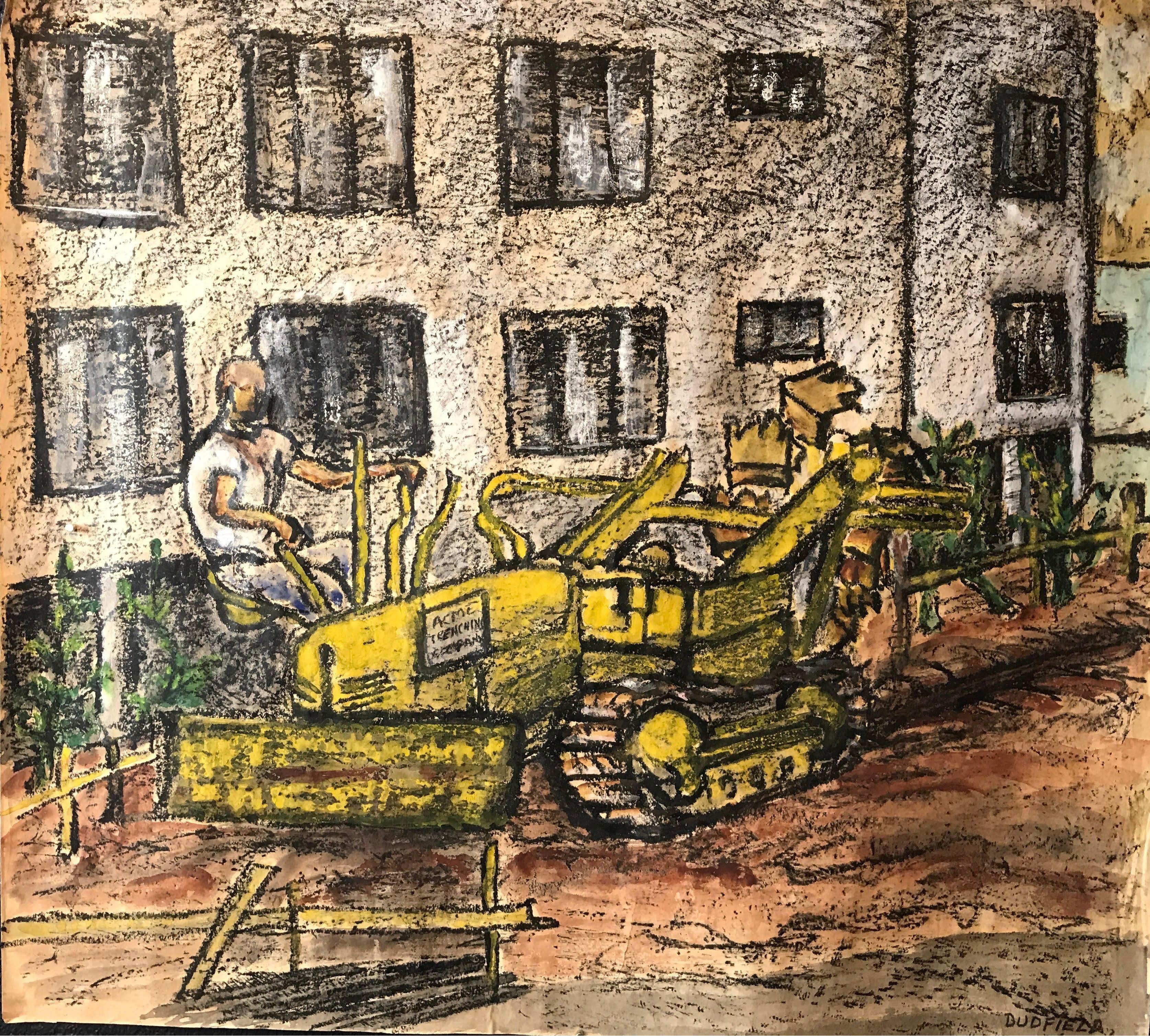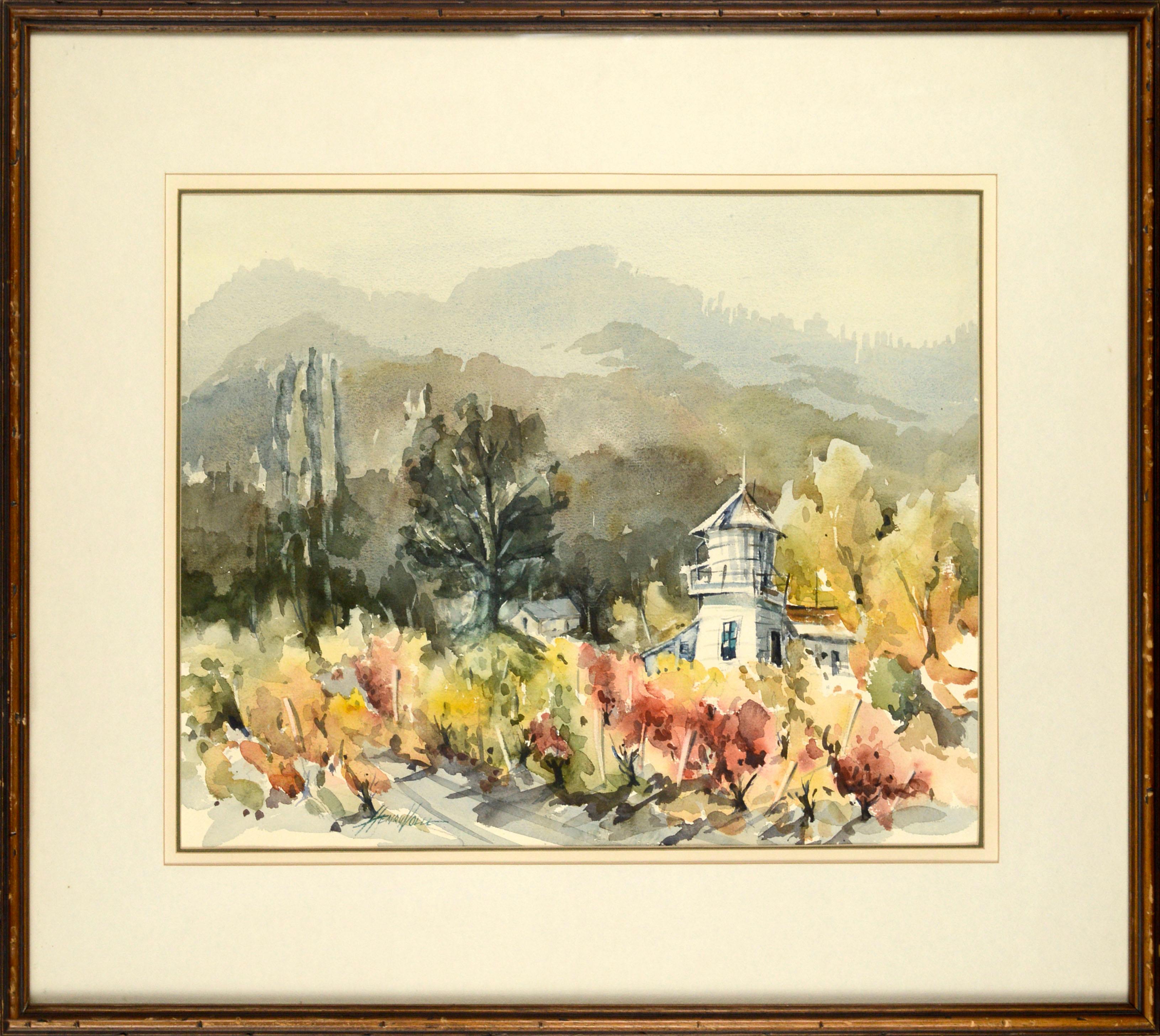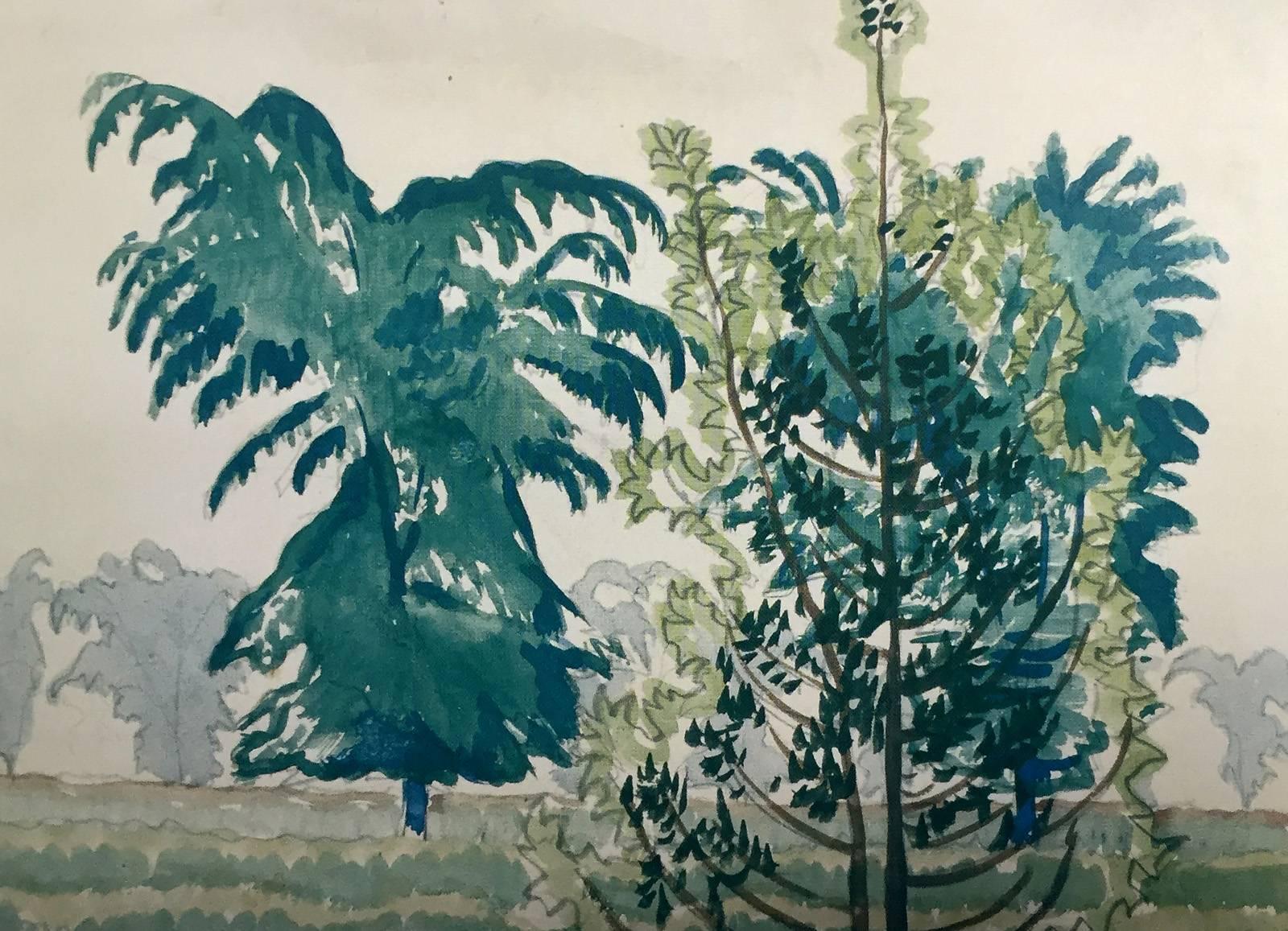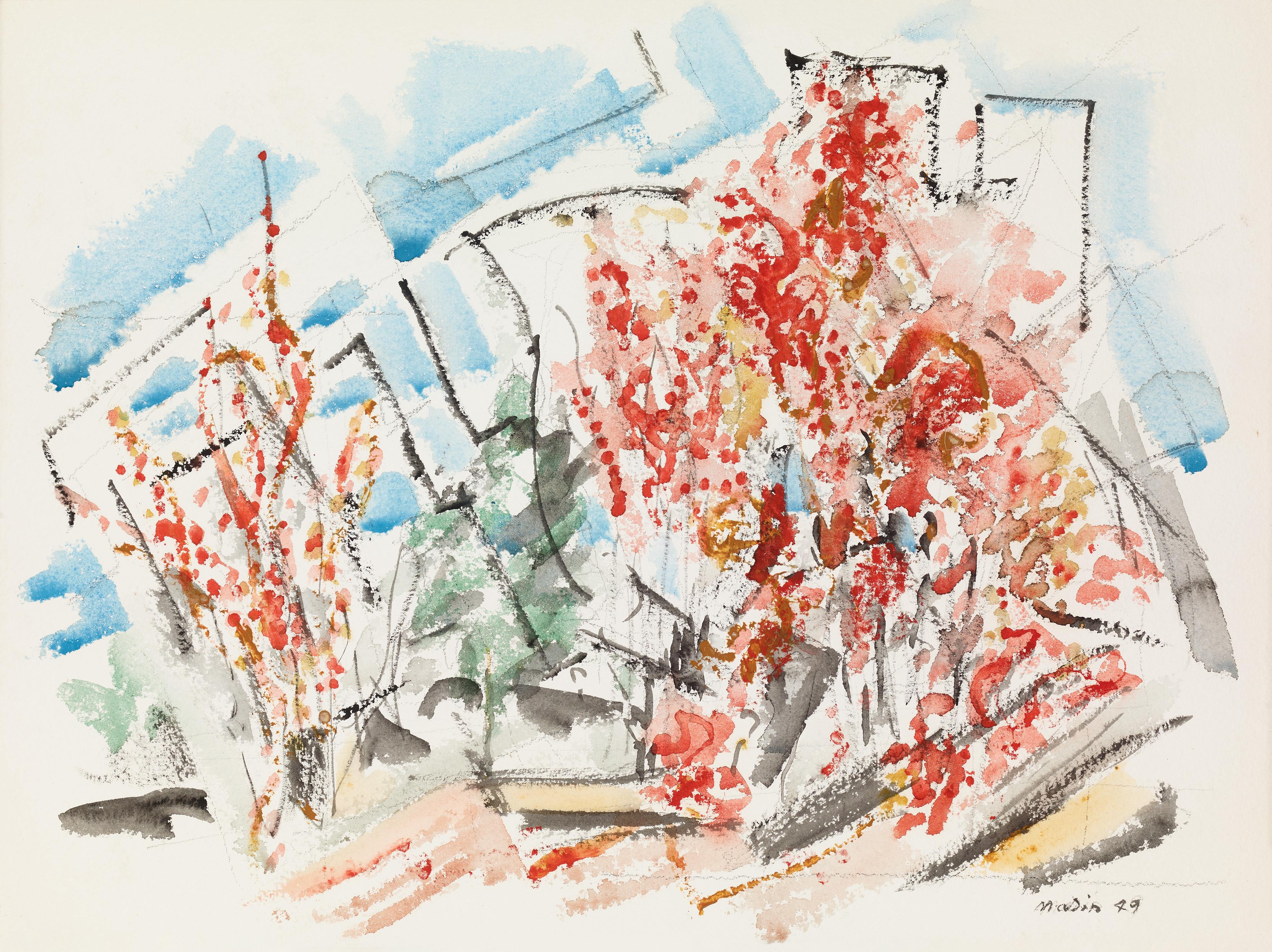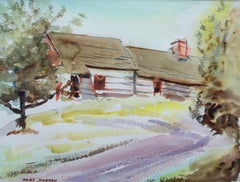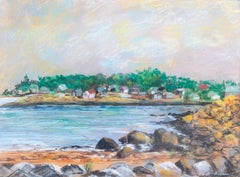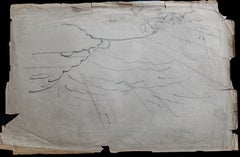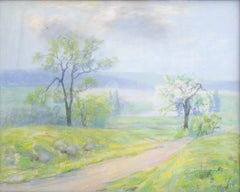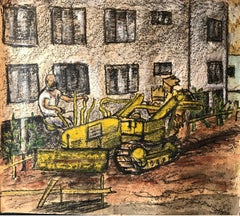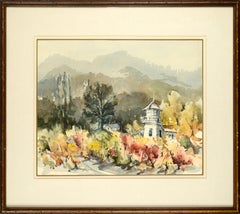Items Similar to Watercolor of Doylestown, PA by Ranulph Bye
Want more images or videos?
Request additional images or videos from the seller
1 of 9
Ranulph ByeWatercolor of Doylestown, PA by Ranulph Bye1958
1958
About the Item
Ranulph Bye (American, 1916-2003)
Rocks and Trees (Doylestown, PA), 1958
Watercolor on paper
14 x 21 in.
Framed: 23 1/8 x 30 1/4 in.
Signed bottom: Ranulph Bye
Ranulph Bye was born in 1916 in Princeton, NJ. He attended the Philadelphia Museum School of Industrial Art, now Philadelphia College of Art, and the Art Students League in New York. His paintings have received national recognition, and he has exhibited in the National Academy of Design, the American Watercolor Society, and Allied Artists.
His work is in the collection of the Boston Museum of Fine Arts, the Moore College of Art, Temple University School of Pharmacy; Munson-Williams- Proctor Institute, Utica, NY; the Reading Museum; the Smithsonian Institution and the William Penn Memorial Museum in Harrisburg. Mr. Bye's work has appeared in American Heritage and American Artist.
He is a member of the Philadelphia Water Color Club, the American Watercolor Society, Allied Artists of America and the National Academy of Design (Academician). Also the Salmagundi Club of New York. His paintings have earned him many prizes. "Painting Buildings in Watercolor" was published by North Light Books in 1994. Other books are "Ranulph Bye's Bucks County" published in 1989 and "Victorian Sketchbook" which is a pictorial journey of Victorian architecture around the country published in 1980. His newest book is "Ranulph Bye's Collection of Old Firehouses".
Now retired from Moore College of Art where he taught for thirty years, Mr. Bye devotes most of his time to painting in and around his native Bucks County, Pennsylvania home.
According to the biography of the artist posted by the Bucks County Museum in Doylestown, Pennsylvania, Ranulph Bye died on November 19, 2003.
He is described as "one of the foremost watercolorists in the country, who since 1953 painted over three-thousand watercolor scenes, mostly rural American landscapes, seascapes, rural America and buildings, especially Victorian style for his book, "Victorian Sketchbook".
A Bucks County regionalist painter tied to the New Hope Colony, Bye was from long-time Pennsylvania family who have held a land grant from William Penn from 1699.
Bio sourced from the Archives of AskArt.
- Creator:Ranulph Bye (1916 - 2003)
- Creation Year:1958
- Dimensions:Height: 23.125 in (58.74 cm)Width: 30.25 in (76.84 cm)Depth: 0.5 in (1.27 cm)
- More Editions & Sizes:Unique 1 of 1Price: $700
- Medium:
- Movement & Style:
- Period:
- Condition:Not examined outside of frame.
- Gallery Location:New York, NY
- Reference Number:Seller: BL11stDibs: LU2211212087202
About the Seller
5.0
Vetted Professional Seller
Every seller passes strict standards for authenticity and reliability
1stDibs seller since 2022
74 sales on 1stDibs
Typical response time: 7 hours
- ShippingRetrieving quote...Shipping from: New York, NY
- Return Policy
Authenticity Guarantee
In the unlikely event there’s an issue with an item’s authenticity, contact us within 1 year for a full refund. DetailsMoney-Back Guarantee
If your item is not as described, is damaged in transit, or does not arrive, contact us within 7 days for a full refund. Details24-Hour Cancellation
You have a 24-hour grace period in which to reconsider your purchase, with no questions asked.Vetted Professional Sellers
Our world-class sellers must adhere to strict standards for service and quality, maintaining the integrity of our listings.Price-Match Guarantee
If you find that a seller listed the same item for a lower price elsewhere, we’ll match it.Trusted Global Delivery
Our best-in-class carrier network provides specialized shipping options worldwide, including custom delivery.More From This Seller
View All4 American Watercolors, c. 1950s, by Mary M. Johnsen
Located in New York, NY
Mary M. Johnsen
Four Paintings, c. 1950s
Watercolor
Dimensions:
1. Mat: 18 x 21 1/4 in., page: 8 x 12 1/4 in.
2. Page: 14 7/8 x 22 in.
3. Mat: 15 x 19 in., page: 10 1/2 x 14 1/2 in....
Category
1950s American Modern Landscape Drawings and Watercolors
Materials
Paper, Watercolor
Lovely Impressionist Coastal Scene of New York in Pastel
Located in New York, NY
Untitled (Coastal New York)
Pastel on paper
17 1/2 x 23 1/2 in.
Framed: 24 1/2 x 30 in.
Signed lower right
Category
20th Century American Modern Landscape Drawings and Watercolors
Materials
Paper, Pastel
Charles Burchfield Preparatory Sketch, Early 20th Century
By Charles E. Burchfield
Located in New York, NY
Charles Burchfield (1893-1967)
Untitled (Preparatory Drawing for Skyscape), Early 20th Century
Pencil on paper
12 1/4 x 18 3/4 in.
Inscribed: blue / white / blue / RV
Born in Ashtab...
Category
Early 20th Century American Modern Landscape Drawings and Watercolors
Materials
Paper, Pencil
Beautiful large impressionist pastel by Francesco Spicuzza
By Francesco Spicuzza
Located in New York, NY
Francesco Spicuzza (American, 1883-1962)
Untitled Landscape, 20th century
Pastel on paper
Sight size: 24 x 30 in.
Framed: 26 1/4 x 32 3/8 in.
Signed lower right: Spicuzza
Italian-born Francesco Spicuzza was primarily a Wisconsin painter who did portraits, still-lives and local landscapes. He spent the first part of his life in near-poverty to become a painter. An eternal optimist, in 1917, the artist reported: "I am happy and my only ambition now is to paint better and better until I shall have reached the measure of the best of which I am capable." (Spicuzza, 1917, p. 22). His predilection for beach scenes germinated early: reportedly, the five-year-old boy first drew the outlines of his father's fishing boat in the sand on the seashore near their home in Sicily. After setting himself up as a fruit peddler in Milwaukee, Spicuzza's father sent for his family when Francesco was eight years old. For the following six years the boy was unable to attend school because of his job in his father's fruit and vegetable business. The poor lad suffered a caved-in shoulder from carrying a heavy wooden crate.
The young Spicuzza was aided by moral and financial support from a sympathetic Milwaukee businessman named John Cramer, publisher and editor of the Evening Wisconsin, who raised Spicuzza's salary as a newspaper assembler so that he could attend school. In 1899 or 1900, Spicuzza began studying drawing and anatomy under Robert Schade (1861-1912), a painter of panoramas who had been trained in Munich under Carl Theodor von Piloty. Spicuzza was also taught by Alexander Mueller (1872-1935), a product of the Weimar and Munich academies. Mueller realized Spicuzza was a colorist and encouraged that orientation (Madle, 1961). Spicuzza found it beneficial to accept an apprenticeship in a lithographic studio for $8 a week, which demanded most of his time. During the St. Louis Universal Exposition in 1904, still a struggling student, Spicuzza attended the fair, thanks to Cramer. It was not long before Spicuzza received a twenty-five dollar portrait commission, and this inaugural success led to new commissions and allowed him to continue as a painter.
The earliest influences in his work appear to be from Edward H. Potthast and Maurice Prendergast, though Spicuzza never mentioned either artist. Already in August 1910, Spicuzza was described in a newspaper as "one of the most talented of Milwaukee's rising workers." He undoubtedly received lasting inspiration from his one summer study period in 1911 with John F. Carlson at the Art Students League's Summer School in Woodstock, New York. Certainly Spicuzza would have picked up spontaneity in handling the brush from Carlson. Although he executed numerous still-lives and an occasional religious work, Spicuzza is best known for his Milwaukee beach scenes populated with frolicking bathers in multi-colored attire, not unlike the images of Potthast, who used a similar technique. Many of these are small, preparatory works on canvas board executed between 1910 and 1915. Frequently with even greater animation than Potthast, Spicuzza produced moving images of youthful energy and uninhibited child's play. These beach genre scenes reflect the attitude of American impressionists who depicted the more pleasant side of life.
Spicuzza manipulated a successful balance of rich pigment applied in varying degrees of impasto texture with subtle nuances of hue. Working all'aperto, he sought "the soft enticing shades of yellow, blue, green, pink and lavender . . . to get the effects of bright glistening summer air." (L.E.S., n.d.). As a painter whose color not only derived from direct observation but also from a personal theory of color symbolism, Spicuzza traded the linear approach of lithography for dynamic patches of brilliant color. Like Prendergast, he would often tilt the angle of the picture plane to bring the viewer's position above the scene.
Spicuzza was unable to enter the 1913 Armory Show or the Panama-Pacific International Exposition two years later but he did submit work to the annual exhibitions of the Pennsylvania Academy of the Fine Arts and those of the Art Institute of Chicago. His first important award was the bronze medal presented by the St. Paul Institute in 1913, which was followed by the silver medal two years later. Before long, Spicuzza had acquired a greater sense of security in his profession and was described by a writer in International Studio (April 1917) as "an independent artist with an assured future. His pastels and water-colours are poetic and joyous bits of nature with a genuine out-of-door feeling." In 1918, his Spirit of Youth, exhibited at the National Academy of Design, sold for $112.50. Four years later, the artist achieved his greatest local recognition by winning the gold medal from the Milwaukee Art Institute.
Spicuzza spent a great deal of time painting en plein air and by 1925 he began summering at Big Cedar Lake, near West Bend, Wisconsin to gather his subject matter. Easter Morning (1926) owes something to the Symbolist movement, with its figure of Christ appearing over a seascape. During the difficult era of the Depression, patrons came to Spicuzza's aid and during the 40s, he taught housewives, businessmen and students at the Milwaukee Art Institute, the Milwaukee Art Center, and in his private studio. In the following decade, although his kind of art was no longer popular in the "make-it-or-break-it" New York gallery world, Spicuzza enjoyed regular patronage and sales. His beach scenes became more static and he would experiment with modernist techniques. Spicuzza died at the age of seventy-eight.
Sources:
L.E.S., "Do Colors Change a Person's disposition? Experiments of a Milwaukee Artist...
Category
20th Century American Modern Landscape Drawings and Watercolors
Materials
Paper, Pastel
Japanese Brush Painting by Mystery Artist
Located in New York, NY
Japanese Brush Painting
Watercolor on handmade paper
28 1/2 x 22 in.
Framed: 32 1/2 x 26 1/4 in.
Category
20th Century Naturalistic Landscape Drawings and Watercolors
Materials
Watercolor, Handmade Paper
Watercolor by Hungarian artist Ede Halápy, titled "Tavassfal" or "Spring Wall"
Located in New York, NY
Ede Halápy (Hungarian, 1891-1962)
Tavasfall (Spring wall), c. 1940
Watercolor on paper
Sight size: 11 1/4 x 10 1/2 in.
Framed: 22 1/4 x 21 1/2 in.
Signed lower right: Halápy
Hungar...
Category
Mid-20th Century Impressionist Landscape Drawings and Watercolors
Materials
Watercolor, Archival Paper
You May Also Like
Canyon with Bridge
Located in Los Angeles, CA
Gordena Parker Jackson (1900 - 1993), Canyon with Bridge, 1939, watercolor on paper, signed and dated lower right, 17 ½ x 13 inches (sight), inscription verso reads: “Watercolor Comp...
Category
1930s American Modern Landscape Drawings and Watercolors
Materials
Paper, Watercolor
Oil Tanks, Alameda Street, Los Angeles
Located in Los Angeles, CA
Oil Tanks, Alameda Street, Los Angeles, c. 1930-33, watercolor on paper, 14 ¼ x 21 ¼ inches (image), inscribed verso: “watercolor by Ruth Zimmerman 1912 – 1968 / Practice work for sc...
Category
1930s American Modern Landscape Drawings and Watercolors
Materials
Paper, Watercolor
1964 San Francisco Construction Site Large Gouache and Pastel Landscape
By Gloria Dudfield
Located in Arp, TX
Gloria Dudfield
Tractor at Work
6-10-64
Gouache and Oil Pastel on Paper
36"x32 1/2" Unframed
Signed and dated lower right in crayon
Very Good Condition - Minor wear consistent with ...
Category
1960s American Modern Mixed Media
Materials
Paper, Oil Pastel, Gouache
Mountain Vineyard Landscape Watercolor
By Henry Hank Volle
Located in Soquel, CA
Beautiful watercolor landscape of a white farmhouse beside a colorful California vineyard with tall mountains fading into the distance Henry Hank Volle (American, 20th Century). This scene was painted on Hecker Pass in the Santa Cruz mountains...
Category
Late 20th Century American Modern Landscape Drawings and Watercolors
Materials
Paper, Watercolor
$700 Sale Price
20% Off
Untitled (Trees)
By Charles E. Burchfield
Located in Buffalo, NY
An original watercolor on paper by American modernist Charles E. Burchfield, created in 1916.
This work comes in an archival frame presentation and has been authenticated by the Bur...
Category
1910s American Modern Landscape Drawings and Watercolors
Materials
Paper, Watercolor
Maples in Autumn Foliage
By John Marin
Located in Bryn Mawr, PA
John Marin’s long and prolific career is best marked by his fervent love of painting and abiding belief that art must relate to lived experiences. His best work strikes a delicate ba...
Category
1940s American Modern Landscape Drawings and Watercolors
Materials
Paper, Watercolor
Recently Viewed
View AllMore Ways To Browse
American Watercolor Society
Watercolor Seascape
Temple University Vintage
Industrial Landscape Watercolor
Bucks County Pennsylvania
William Temple
New Hope Pa
William Penn
New Hope Pa Painting
Philadelphia Country Club
Victorian Water Color Painting
Paintings Signed Williams Trees
Victorian Pharmacy
Inga Palmgren Drawing
Isabel Wrightson
Isabelle Schrock Barnett
J Kleinschmidt
James Gunnell
